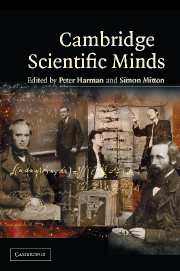Book contents
- Frontmatter
- Contents
- Foreword
- Introduction
- 1 William Gilbert
- 2 William Harvey
- 3 Isaac Newton: Creator of the Cambridge scientific tradition
- 4 William Whewell: A Cambridge historian and philosopher of science
- 5 Adam Sedgwick: A confident mind in turmoil
- 6 Charles Babbage: Science and reform
- 7 Charles Darwin
- 8 Stokes and Kelvin, Cambridge and Glasgow, light and heat
- 9 James Clerk Maxwell
- 10 The duo from Trinity: A.N. Whitehead and Bertrand Russell on the foundations of mathematics, 1895–1925
- 11 Thomson, Rutherford and atomic physics at the Cavendish
- 12 Hopkins and biochemistry
- 13 Charles Sherrington, E.D. Adrian, and Henry Dale: The Cambridge Physiological Laboratory and the physiology of the nervous system
- 14 Hardy and Littlewood
- 15 Arthur Stanley Eddington
- 16 Paul Dirac: A quantum genius
- 17 Alan Turing
- 18 Francis Crick and James Watson
- 19 Mary Cartwright
- 20 Joseph Needham
- 21 Molecular biology in Cambridge
- 22 The discovery of pulsars – prelude and aftermath
- 23 Stephen W. Hawking
3 - Isaac Newton: Creator of the Cambridge scientific tradition
Published online by Cambridge University Press: 05 June 2014
- Frontmatter
- Contents
- Foreword
- Introduction
- 1 William Gilbert
- 2 William Harvey
- 3 Isaac Newton: Creator of the Cambridge scientific tradition
- 4 William Whewell: A Cambridge historian and philosopher of science
- 5 Adam Sedgwick: A confident mind in turmoil
- 6 Charles Babbage: Science and reform
- 7 Charles Darwin
- 8 Stokes and Kelvin, Cambridge and Glasgow, light and heat
- 9 James Clerk Maxwell
- 10 The duo from Trinity: A.N. Whitehead and Bertrand Russell on the foundations of mathematics, 1895–1925
- 11 Thomson, Rutherford and atomic physics at the Cavendish
- 12 Hopkins and biochemistry
- 13 Charles Sherrington, E.D. Adrian, and Henry Dale: The Cambridge Physiological Laboratory and the physiology of the nervous system
- 14 Hardy and Littlewood
- 15 Arthur Stanley Eddington
- 16 Paul Dirac: A quantum genius
- 17 Alan Turing
- 18 Francis Crick and James Watson
- 19 Mary Cartwright
- 20 Joseph Needham
- 21 Molecular biology in Cambridge
- 22 The discovery of pulsars – prelude and aftermath
- 23 Stephen W. Hawking
Summary
In the mid seventeenth century, mathematics and science were accorded no greater importance in the University of Cambridge than in other universities throughout Europe. One hundred years later the position was quite different. Though the traditional academic ‘exercises’ still took place, the ability of graduands was judged by their performance in the Senate House Examination or Mathematical ‘Tripos’. During the seventeenth century, traditions of teaching mathematical subjects, ‘natural philosopy’ (i.e., physical science), and medicine were modernised in many European countries, including Britain, but the influence of Isaac Newton (1642–1727) brought about particularly swift and far-reaching changes at Cambridge, his own university.
As Lucasian Professor of Mathematics for nearly thirty years from 1669, Newton set some of his own discoveries before his auditors (few enough) without ever proposing any general reform of education, while in private – in documents long unread and showing little desire to alter the balance between humane and mathematical or scientific studies – he increased the latter's importance. Most interesting in these drafts is the new role of a mathematically based natural philosophy, for which students were to be prepared by courses in geometry and mechanics, that is, ‘the demonstrative doctrine of motions … For without a judgement in these things a man can have none in [natural] philosophy.’ The latter subject Newton explained as the investigation of those matters which he himself had so far advanced in his Mathematical Principles of Natural Philosophy [Principia] (1687), beginning with an understanding of time, space, body, and motion, moving on to rational and fluid mechanics, astronomy and cosmology, then ending ‘if the [lecturer] have skill therein’ with knowledge of minerals, vegetables, and anatomy.
- Type
- Chapter
- Information
- Cambridge Scientific Minds , pp. 36 - 50Publisher: Cambridge University PressPrint publication year: 2002



